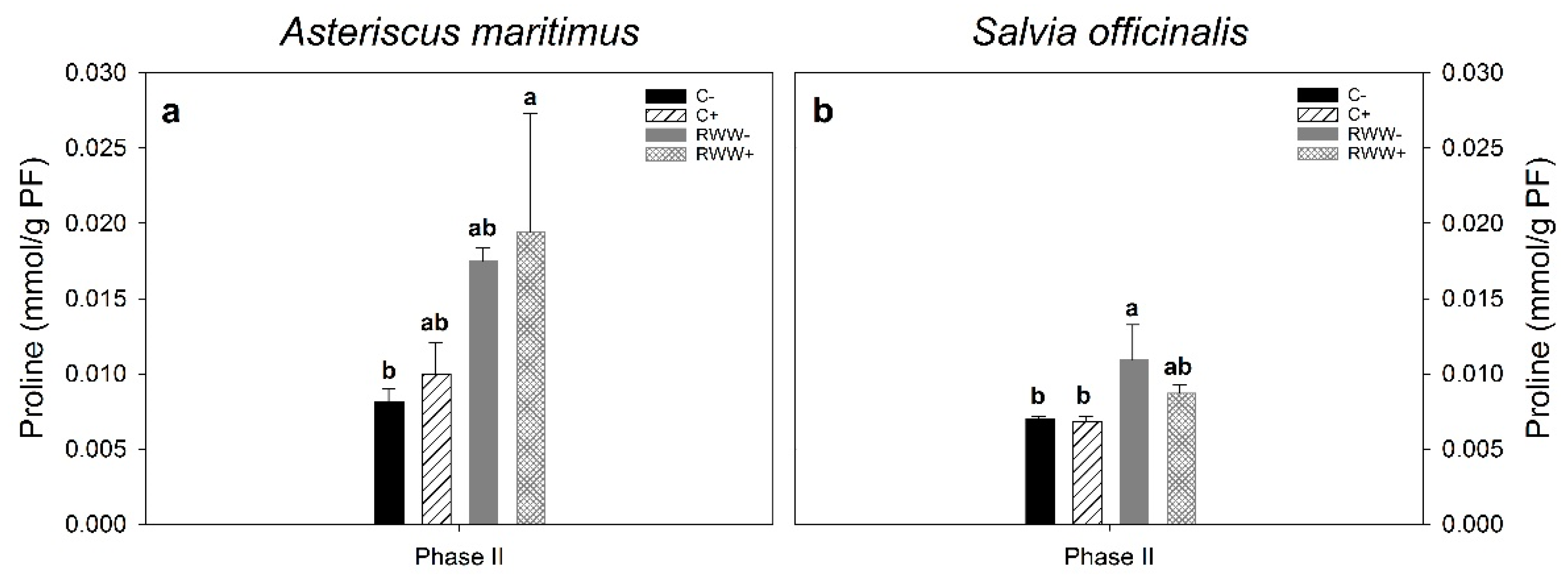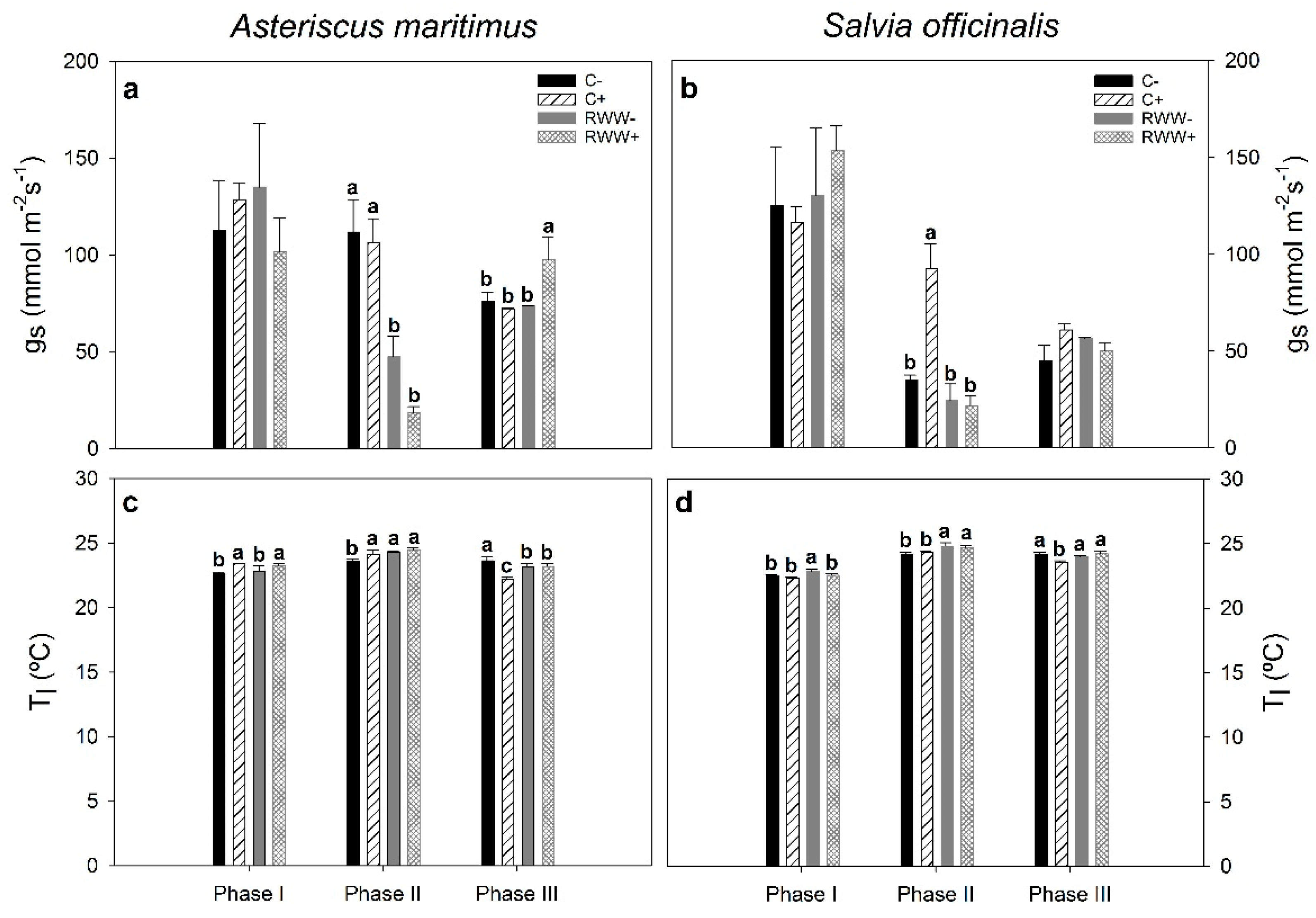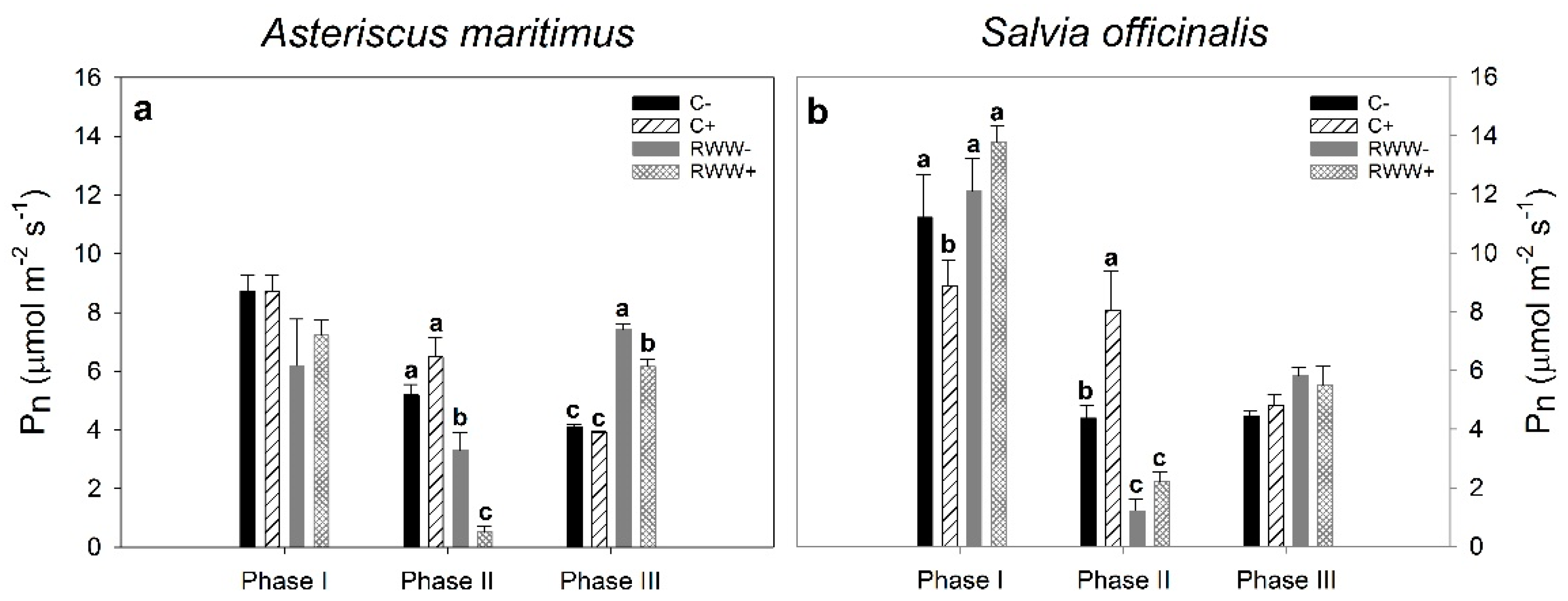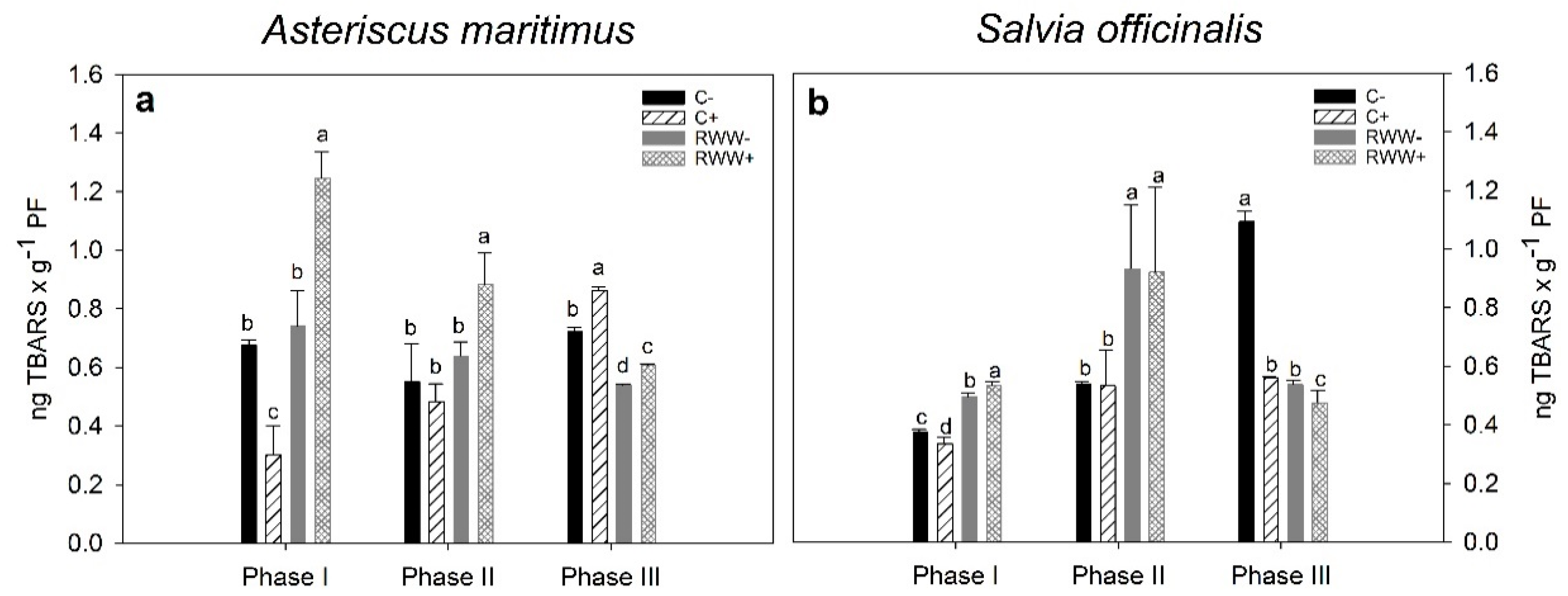Tolerance and Recovery Capacity to Reclaimed Wastewater Irrigation of Salvia officinalis and Asteriscus maritimus Plants Inoculated with Arbuscular Mycorrhizae
Abstract
1. Introduction
2. Materials and Methods
2.1. Plant Material and Experimental Conditions
2.2. Treatments
- A first “pre-stress” phase, in which all the plants were watered with good quality water (33 days; phase I).
- A second phase of stress, in which half of the plants were irrigated with RWW (51 days; phase II).
- A final recovery phase (29 days; phase III), in which the plants were irrigated again with good quality water.
2.3. Fungal Colonization
2.4. Biomass and Leaf Area
2.5. Substrate and Plant Mineral Content
2.6. Water Relations
2.7. Gas Exchange and Leaf Temperature
2.8. Chlorophyll Fluorescence
2.9. Proline Content
2.10. Lipid Peroxidation
2.11. Statistical Analysis
3. Results
3.1. Mycorrhization Percentage
3.2. Biomass and Leaf Area
3.3. Substrate and Plant Mineral Content
3.3.1. Na+ and Cl− Ion Content in the Substrate
3.3.2. Na+ and Cl− Ion Content in Root and Aerial Part
3.4. Water Relations
3.5. Proline Content
3.6. Gas Exchange and Thermography
3.7. Clorophyll Fluorescence
3.8. Lipid Peroxidation
4. Discussion
5. Conclusions
Author Contributions
Funding
Institutional Review Board Statement
Data Availability Statement
Conflicts of Interest
References
- Acosta-Motos, J.R.; Álvarez, S.; Barba-Espín, G.; Hernández, J.A.; Sánchez-Blanco, M.J. Salts and nutrients present in regenerated waters induce changes in water relations, antioxidative metabolism, ion accumulation and restricted ion uptake in Myrtus communis L. plants. Plant Physiol. Biochem. 2014, 85, 41–50. [Google Scholar] [CrossRef] [PubMed]
- Grattan, S.R.; Díaz, F.J.; Pedrero, F.; Vivaldi, G.A. Assessing the suitability of saline wastewaters for irrigation of Citrus spp.: Emphasis on boron and specific-ion interactions. Agric. Water Manag. 2015, 157, 48–58. [Google Scholar] [CrossRef]
- Gómez-Bellot, M.J.; Ortuño, M.F.; Nortes, P.A.; Vicente-Sánchez, J.; Bañón, S.; Sánchez-Blanco, M.J. Mycorrhizal euonymus plants and reclaimed water: Biomass, water status and nutritional responses. Sci. Hortic. 2015, 186, 61–69. [Google Scholar] [CrossRef]
- Acosta-Motos, J.R.; Ortuño, M.F.; Bernal-Vicente, A.; Díaz-Vivancos, P.; Sánchez-Blanco, M.J.; Hernández, J.A. Plant Responses to Salt Stress: Adaptive Mechanisms. Agronomy 2017, 7, 18. [Google Scholar] [CrossRef]
- Lorente, B.; Zugasti, I.; Ortuño, M.F.; Nortes, P.; Bañón, S.; Hernández, J.A.; Sánchez-Blanco, M.J. Substrate composition affects the development of water stress and subsequent recovery by inducing physiological changes in Cistus albidus plants. Plant Physiol. Biochem. 2021, 158, 125–135. [Google Scholar] [CrossRef] [PubMed]
- Conde, A.; Chaves, M.M.; Gerós, H. Membrane transport, sensing and signaling in plant adaptation to environmental stress. Plant Cell Physiol. 2011, 52, 1583–1602. [Google Scholar] [CrossRef] [PubMed]
- Gupta, B.; Huang, B. Mechanism of Salinity Tolerance in Plants: Physiological, Biochemical, and Molecular Characterization. Int. J. Genomics. 2014, 2014, 701596. [Google Scholar] [CrossRef] [PubMed]
- Rodríguez, P.; Torrecillas, A.; Morales, M.A.; Ortuño, M.F.; Sánchez-Blanco, M.J. Effects of NaCl salinity and water stress on growth and leaf water relations of Asteriscus maritimus plants. Environ. Exp. Bot. 2005, 53, 113–123. [Google Scholar] [CrossRef]
- Gómez-Bellot, M.J.; Lorente, B.; Ortuño, M.F.; Medina, S.; Gil-Izquierdo, Á.; Bañón, S.; Sánchez-Blanco, M.J. Recycled Wastewater and Reverse Osmosis Brine Use for Halophytes Irrigation: Differences in Physiological, Nutritional and Hormonal Responses of Crithmum maritimum and Atriplex halimus Plants. Agronomy 2021, 11, 627. [Google Scholar] [CrossRef]
- Es-sbihi, F.Z.; Hazzoumi, Z.; Aasfar, A.; Joutei, K.A. Improving salinity tolerance in Salvia officinalis L. by foliar application of salicylic acid. Chem. Biol. Technol. Agric. 2021, 8, 25. [Google Scholar] [CrossRef]
- Singh, L.P.; Gill, S.S.; Tuteja, N. Unraveling the role of fungal symbionts in plant abiotic stress tolerance. Plant Signal. Behav. 2011, 6, 175–191. [Google Scholar] [CrossRef] [PubMed]
- Bonfante, P.; Genre, A. Mechanisms underlying beneficial plant—Fungus interactions in mycorrhizal symbiosis. Nat. Commun. 2010, 1, 48. [Google Scholar] [CrossRef] [PubMed]
- Smith, S.; Read, D. Mycorrhizal Symbiosis, 3rd ed.; Elsevier: Amsterdam, The Netherlands, 2008; ISBN 978-0-12-370526-6. [Google Scholar]
- Blaszkowski, J.; Wubet, T.; Harikumar, V.S.; Ryszka, P.; Buscot, F. Glomus indicum, a new arbuscular mycorrhizal fungus. Botany 2010, 88, 132–143. [Google Scholar] [CrossRef]
- Fernández, F.; Juárez, J. Procedimiento de Obtención de un Agente Micorrizógeno. Patent ES201130566A, 11 March 2011. [Google Scholar]
- Kormanik, P.P.; McGraw, A.C. Quantification of Vesicular-Arbuscular Mycorrhizae in plant roots. In Methods and Principles of Mycorrhizal Research; Schenck, N.C., Ed.; The American Phytopathological Society: Saint Paul, MN, USA, 1982; pp. 37–45. [Google Scholar]
- Sieverding, E. Manual de Métodos para la Investigación de la Micorriza Vesículo-Arbuscular en el Laboratorio; Centro Internacional de Agricultura Tropical (CIAT): Cali, Colombia, 1983. [Google Scholar]
- Scholander, P.F.; Hammel, H.T.; Bradstreet, E.D.; Hemmingsen, E.A. Sap pressure in vascular plants. Science 1965, 148, 339–346. [Google Scholar] [CrossRef] [PubMed]
- Gucci, R.; Xiloyannis, C.; Flore, J.A. Gas exchange parameters water relations and carbohydrate partitioning in leaves of field-grown Prunus domestica following fruit removal. Physiol. Plant. 1991, 83, 497–505. [Google Scholar] [CrossRef]
- Jones, H.G. Use of infrared thermometry for estimation of stomatal conductance as a possible aid to irrigation scheduling. Agric. For. Meteorol. 1999, 95, 139–149. [Google Scholar] [CrossRef]
- Grant, O.M.; Tronina, Ł.; Jones, H.G.; Chaves, M.M. Exploring thermal imaging variables for the detection of stress responses in grapevine under different irrigation regimes. J. Exp. Bot. 2007, 58, 815–825. [Google Scholar] [CrossRef] [PubMed]
- Bates, L.S.; Waldren, R.P.; Teare, I.D. Rapid determination of free proline for water-stress studies. Plant Soil. 1973, 39, 205–207. [Google Scholar] [CrossRef]
- Cakmak, I.; Horst, W.J. Effect of aluminium on lipid peroxidation, superoxide dismutase, catalase, and peroxidase activities in root tips of soybean (Glycine max). Physiol. Plant. 1991, 83, 463–468. [Google Scholar] [CrossRef]
- Aggarwal, A.; Kadian, N.; Tanwar, A.; Gupta, K.K. Arbuscular mycorrhizal symbiosis and alleviation of salinity stress. J. Appl. Nat. Sci. 2012, 4, 144–155. [Google Scholar] [CrossRef]
- Pedrero, F.; Grattan, S.R.; Ben-Gal, A.; Vivaldi, G.A. Opportunities for expanding the use of wastewaters for irrigation of olives. Agric. Water Manag. 2020, 241, 106333. [Google Scholar] [CrossRef]
- Hameed, A.; Dilfuza, E.; Abd-Allah, E.F.; Hashem, A.; Kumar, A.; Ahmad, P. Salinity Stress and Arbuscular Mycorrhizal Symbiosis in Plants. In Use of Microbes for the Alleviation of Soil Stresses; Miransari, M., Ed.; Springer: New York, NY, USA, 2004; Volume 1. [Google Scholar]
- Estrada, B.; Aroca, R.; Azcón-Aguilar, C.; Barea, J.M.; Ruiz-Lozano, J.M. Importance of native arbuscular mycorrhizal inoculation in the halophyte Asteriscus maritimus for successful establishment and growth under saline conditions. Plant Soil. 2013, 370, 175–185. [Google Scholar] [CrossRef]
- Abdel-Fattah, G.M.; Rabie, G.H.; Lamis, D.S.; Rabab, A.M. The Impact of the Arbuscular Mycorrhizal Fungi on Growth and Physiological Parameters of Cowpea Plants Grown under Salt Stress Conditions. Int. J. Appl. Sci. Biotechnol. 2016, 4, 372. [Google Scholar] [CrossRef][Green Version]
- Kumar, A.; Sharma, S.; Mishra, S. Influence of arbuscular mycorrhizal (AM) fungi and salinity on seedling growth, solute accumulation, and mycorrhizal dependency of Jatropha curcas L. J. Plant Growth Regul. 2010, 29, 297–306. [Google Scholar] [CrossRef]
- Gómez-Bellot, M.J.; Álvarez, S.; Castillo, M.; Bañón, S.; Ortuño, M.F.; Sánchez-Blanco, M.J. Water relations, nutrient content and developmental responses of Euonymus plants irrigated with water of different degrees of salinity and quality. J. Plant Res. 2013, 126, 567–576. [Google Scholar] [CrossRef] [PubMed]
- Valdez-Aguilar, L.A.; Grieve, C.M.; Razak-Mahar, A.; McGiffen, M.E.; Merhaut, D.J. Growth and ion distribution is affected by irrigation with saline water in selected landscape species grown in two consecutive growing seasons: Spring-summer and fall-winter. HortScience 2011, 46, 632–642. [Google Scholar] [CrossRef]
- Bahtiyarca Bagdat, R.; Craker, L.E.; Yuksel, K. The effect of fertilization and Mycorrhiza inoculation on yield variables and essential oil characteristics of Salvia officinalis L. growing in the greenhouse and at the field. Indian J. Pharm. Educ. Res. 2017, 51, S341–S348. [Google Scholar] [CrossRef]
- Álvarez, S.; Rodríguez Hernández, P.; Broetto, F.; Sánchez-Blanco, M.J. Long term responses and adaptive strategies of Pistacia lentiscus under moderate and severe deficit irrigation and salinity: Osmotic and elastic adjustment, growth, ion uptake and photosynthetic activity. Agric. Water Manag. 2018, 202, 253–262. [Google Scholar] [CrossRef]
- Koyro, H.W. Effect of salinity on growth, photosynthesis, water relations and solute composition of the potential cash crop halophyte Plantago coronopus (L.). Environ. Exp. Bot. 2006, 56, 136–146. [Google Scholar] [CrossRef]
- Vicente-Sánchez, J.; Nicolás, E.; Pedrero, F.; Alarcón, J.J.; Maestre-Valero, J.F.; Fernández, F. Arbuscular mycorrhizal symbiosis alleviates detrimental effects of saline reclaimed water in lettuce plants. Mycorrhiza 2014, 24, 339–348. [Google Scholar] [CrossRef] [PubMed]
- Evelin, H.; Kapoor, R.; Giri, B. Arbuscular mycorrhizal fungi in alleviation of salt stress: A review. Ann. Bot. 2009, 104, 1263–1280. [Google Scholar] [CrossRef]
- Borde, M.; Dudhane, M.; Jite, P.K. AM Fungi Influences the Photosynthetic Activity, Growth and Antioxidant Enzymes in Allium sativum L. under Salinity Condition. Not. Sci. Biol. 2010, 2, 64–71. [Google Scholar] [CrossRef]
- Moradi, F.; Ismail, A.M. Responses of photosynthesis, chlorophyll fluorescence and ROS-scavenging systems to salt stress during seedling and reproductive stages in rice. Ann. Bot. 2007, 99, 1161–1173. [Google Scholar] [CrossRef]
- Zuccarini, P.; Okurowska, P. Effects of mycorrhizal colonization and fertilization on growth and photosynthesis of sweet basil under salt stress. J. Plant Nutr. 2008, 31, 497–513. [Google Scholar] [CrossRef]
- Sheng, M.; Tang, M.; Chen, H.; Yang, B.; Zhang, F.; Huang, Y. Influence of arbuscular mycorrhizae on photosynthesis and water status of maize plants under salt stress. Mycorrhiza 2008, 18, 287–296. [Google Scholar] [CrossRef] [PubMed]
- Aslani, H.; Razmjoo, J. Common sage (Salvia officinalis L.) responses to salinity and drought stresses in Isfahan region. Acta Hortic. 2018, 1190, 145–150. [Google Scholar] [CrossRef]






| Asteriscus maritimus | Salvia officinalis | |||
|---|---|---|---|---|
| C+ | RWW+ | C+ | RWW+ | |
| Phase II | 33.00 ± 2.87 a | 37.00 ± 4.07 aA | 13.70 ± 2.22 b | 15.67 ± 2.47 bA |
| Phase III | 29.50 ± 4.65 a | 18.00 ± 5.51 bB | 10.17 ± 1.93 c | 10.33 ± 1.80 cB |
| Leaf Area (mm2) | |||
|---|---|---|---|
| Asteriscus maritimus | Salvia officinalis | ||
| Phase I | C− | 257.25 ± 12.75 a | 915.92 ± 8.03 a |
| C+ | 177.21 ± 4.04 b | 931.42 ± 7.58 a | |
| RWW− | 177.33 ± 6.67 b | 821.17 ± 8.62 b | |
| RWW+ | 169.72 ± 2.26 b | 938.75 ± 8.62 a | |
| Phase II | C− | 170.25 ± 4.58 | 1064 ± 31 a |
| C+ | 146.04 ± 15.79 | 906.92 ± 37.92 b | |
| RWW− | 180.50 ± 3.83 | 658.75 ± 13.58 c | |
| RWW+ | 166.92 ± 14.42 | 718.00 ± 21.17 c | |
| Phase III | C− | 194.67 ± 12.93 a | 533.33 ± 7.37 a |
| C+ | 197.83 ± 0.00 a | 528.17 ± 12.11 a | |
| RWW− | 171.33 ± 9.25 b | 318.17 ± 29.67 b | |
| RWW+ | 158.25 ± 13.41 b | 306.67 ± 23.81 b | |
| Asteriscus maritimus | Salvia officinalis | ||||
|---|---|---|---|---|---|
| Na+ (mg/L) | Cl− (mg/L) | Na+ (mg/L) | Cl− (mg/L) | ||
| Phase II | C− | 6.48 ± 0.45 b | 4.90 ± 0.31 b | 5.76 ± 1.86 b | 6.62 ± 0.34 b |
| C+ | 7.03 ± 0.14 b | 4.33 ± 0.55 b | 6.85 ± 0.35 b | 6.67 ± 1.58 b | |
| RWW− | 13.64 ± 0.5 a | 13.91 ± 1.35 a | 16.04 ± 3.38 a | 26.43 ± 2.09 a | |
| RWW+ | 10.50 ± 2.85 ab | 9.84 ± 1.14 a | 16.99 ± 2.97 a | 28.22 ± 3.55 a | |
| Phase III | C− | 7.55 ± 0.25 b | 5.31 ± 2.88 b | 8.02 ± 1.24 b | 9.65 ± 2.51 c |
| C+ | 8.56 ± 1.45 b | 6.87 ± 0.27 b | 7.98 ± 1.24 b | 9.84 ± 2.59 c | |
| RWW− | 19.46 ± 1.33 a | 23.99 ± 5.85 a | 19.12 ± 0.56 a | 27.56 ± 1.30 b | |
| RWW+ | 20.70 ± 1.51 a | 21.86 ± 3.69 a | 21.24 ± 0.98 a | 33.65 ± 2.56 a | |
| A | Asteriscus maritimus | ||||
|---|---|---|---|---|---|
| Na+ (mg/L) | Cl− (mg/L) | ||||
| Aerial Part | Roots | Aerial Part | Roots | ||
| Phase II | C− | 59.71 ± 4.62 | 12.39 ± 4.53 | 88.68 ± 30.30 | 8.72 ± 2.65 |
| C+ | 60.65 ± 3.69 | 8.57 ± 0.56 | 93.77 ± 31.73 | 5.65 ± 0.88 | |
| RWW− | 66.59 ± 12.22 | 14.21 ± 1.12 | 107.08 ± 32.59 | 10.08 ± 4.19 | |
| RWW+ | 68.81 ± 4.57 | 13.74 ± 4.31 | 100.26 ± 36.51 | 12.53 ± 3.24 | |
| Phase III | C− | 23.80 ± 1.58 | 9.04 ± 3.27 | 191.82 ± 14.27 b | 8.08 ± 1.84 |
| C+ | 59.90 ± 9.39 | 15.92 ± 11.97 | 224.36 ± 17.56 ab | 6.79 ± 1.77 | |
| RWW− | 23.25 ± 1.90 | 11.28 ± 1.05 | 165.08 ± 70.78 b | 6.99 ± 3.13 | |
| RWW+ | 50.15 ± 25.07 | 10.27 ± 3.79 | 300.67 ± 17.56 a | 11.88 ± 4.54 | |
| B | Salvia officinalis | ||||
| Na+ (mg/L) | Cl− (mg/L) | ||||
| Aerial Part | Roots | Aerial Part | Roots | ||
| Phase II | C− | 1.80 ± 0.20 b | 4.84 ± 0.49 | 10.42 ± 1.47 b | 8.169 ± 0.87 a |
| C+ | 2.57 ± 0.19 ab | 4.51 ± 0.13 | 9.27 ± 1.15 b | 6.295 ± 0.16 b | |
| RWW− | 4.71 ± 1.69 a | 4.97 ± 0.81 | 20.03 ± 1.94 a | 7.863 ± 3.09 ab | |
| RWW+ | 3.91 ± 0.88 ab | 5.28 ± 0.85 | 20.59 ± 2.78 a | 9.120 ± 1.70 a | |
| Phase III | C− | 2.05 ± 0.12 b | 4.74 ± 1.03 | 12.63 ± 3.27 b | 10.67 ± 2.00 |
| C+ | 1.57 ± 0.34 b | 5.29 ± 0.43 | 14.89 ± 2.77 b | 9.68 ± 1.35 | |
| RWW− | 18.25 ± 9.34 a | 9.07 ± 4.66 | 104.76 ± 45.03 a | 12.04 ± 9.96 | |
| RWW+ | 15.82 ± 3.02 a | 7.51 ± 1.43 | 72.66 ± 10.25 a | 9.84 ± 1.14 | |
| A | Asteriscus maritimus | ||||
|---|---|---|---|---|---|
| Fv/Fm | Y(II) | qP | qN | ||
| Phase I | C− | 0.777 ± 0.005 b | 0.567 ± 0.012 a | 0.842 ± 0.007 a | 0.469 ± 0.013 bc |
| C+ | 0.779 ± 0.005 b | 0.487 ± 0.018 b | 0.722 ± 0.018 c | 0.524 ± 0.017 a | |
| RWW− | 0.796 ± 0.005 a | 0.565 ± 0.008 a | 0.789 ± 0.011 b | 0.433 ± 0.010 c | |
| RWW+ | 0.782 ± 0.002 b | 0.553 ± 0.005 a | 0.806 ± 0.007 b | 0.478 ± 0.018 b | |
| Phase II | C− | 0.789 ± 0.002 | 0.559 ± 0.015 a | 0.785 ± 0.023 a | 0.417 ± 0.013 b |
| C+ | 0.790 ± 0.006 | 0.530 ± 0.018 a | 0.777 ± 0.014 a | 0.471 ± 0.023 a | |
| RWW− | 0.778 ± 0.010 | 0.445 ± 0.008 b | 0.658 ± 0.028 b | 0.335 ± 0.016 c | |
| RWW+ | 0.781 ± 0.008 | 0.550 ± 0.030 a | 0.753 ± 0.040 a | 0.349 ± 0.008 b | |
| Phase III | C− | 0.712 ± 0.017 | 0.520 ± 0.002 | 0.772 ± 0.039 ab | 0.397 ± 0.029 b |
| C+ | 0.715 ± 0.017 | 0.505 ± 0.026 | 0.859 ± 0.021 a | 0.558 ± 0.014 a | |
| RWW− | 0.723 ± 0.016 | 0.428 ± 0.038 | 0.573 ± 0.037 c | 0.341 ± 0.007 b | |
| RWW+ | 0.741 ± 0.014 | 0.503 ± 0.038 | 0.715 ± 0.046 b | 0.507 ± 0.030 a | |
| B | Salvia officinalis | ||||
| Fv/Fm | Y(II) | qP | qN | ||
| Phase I | C− | 0.777 ± 0.002 | 0.475 ± 0.010 | 0.710 ± 0.009 ab | 0.494 ± 0.017 b |
| C+ | 0.780 ± 0.003 | 0.489 ± 0.010 | 0.745 ± 0.012 a | 0.566 ± 0.018 a | |
| RWW− | 0.785 ± 0.004 | 0.455 ± 0.018 | 0.679 ± 0.017 b | 0.549 ± 0.019 ab | |
| RWW+ | 0.782 ± 0.004 | 0.490 ± 0.020 | 0.727 ± 0.009 a | 0.509 ± 0.018 b | |
| Phase II | C− | 0.785 ± 0.004 a | 0.507 ± 0.013 a | 0.789 ± 0.018 a | 0.615 ± 0.014 a |
| C+ | 0.794 ± 0.007 a | 0.523 ± 0.017 a | 0.776 ± 0.006 a | 0.529 ± 0.021 b | |
| RWW− | 0.758 ± 0.012 b | 0.343 ± 0.017 c | 0.594 ± 0.017 c | 0.637 ± 0.017 a | |
| RWW+ | 0.758 ± 0.007 b | 0.399 ± 0.018 b | 0.681 ± 0.022 b | 0.638 ± 0.017 a | |
| Phase III | C− | 0.728 ± 0.018 | 0.345 ± 0.022 b | 0.77 ± 0.017 a | 0.808 ± 0.014 a |
| C+ | 0.732 ± 0.019 | 0.402 ± 0.011 ab | 0.840 ± 0.024 a | 0.806 ± 0.010 a | |
| RWW− | 0.748 ± 0.017 | 0.368 ± 0.026 b | 0.635 ± 0.018 b | 0.671 ± 0.019 c | |
| RWW+ | 0.712 ± 0.013 | 0.453 ± 0.011 a | 0.636 ± 0.062 b | 0.729 ± 0.026 b | |
Publisher’s Note: MDPI stays neutral with regard to jurisdictional claims in published maps and institutional affiliations. |
© 2022 by the authors. Licensee MDPI, Basel, Switzerland. This article is an open access article distributed under the terms and conditions of the Creative Commons Attribution (CC BY) license (https://creativecommons.org/licenses/by/4.0/).
Share and Cite
Lorente, B.; Pulido-Suárez, L.; Ortuño, M.F.; Sánchez-Blanco, M.J. Tolerance and Recovery Capacity to Reclaimed Wastewater Irrigation of Salvia officinalis and Asteriscus maritimus Plants Inoculated with Arbuscular Mycorrhizae. Horticulturae 2022, 8, 159. https://doi.org/10.3390/horticulturae8020159
Lorente B, Pulido-Suárez L, Ortuño MF, Sánchez-Blanco MJ. Tolerance and Recovery Capacity to Reclaimed Wastewater Irrigation of Salvia officinalis and Asteriscus maritimus Plants Inoculated with Arbuscular Mycorrhizae. Horticulturae. 2022; 8(2):159. https://doi.org/10.3390/horticulturae8020159
Chicago/Turabian StyleLorente, Beatriz, Laura Pulido-Suárez, María Fernanda Ortuño, and María Jesús Sánchez-Blanco. 2022. "Tolerance and Recovery Capacity to Reclaimed Wastewater Irrigation of Salvia officinalis and Asteriscus maritimus Plants Inoculated with Arbuscular Mycorrhizae" Horticulturae 8, no. 2: 159. https://doi.org/10.3390/horticulturae8020159
APA StyleLorente, B., Pulido-Suárez, L., Ortuño, M. F., & Sánchez-Blanco, M. J. (2022). Tolerance and Recovery Capacity to Reclaimed Wastewater Irrigation of Salvia officinalis and Asteriscus maritimus Plants Inoculated with Arbuscular Mycorrhizae. Horticulturae, 8(2), 159. https://doi.org/10.3390/horticulturae8020159






